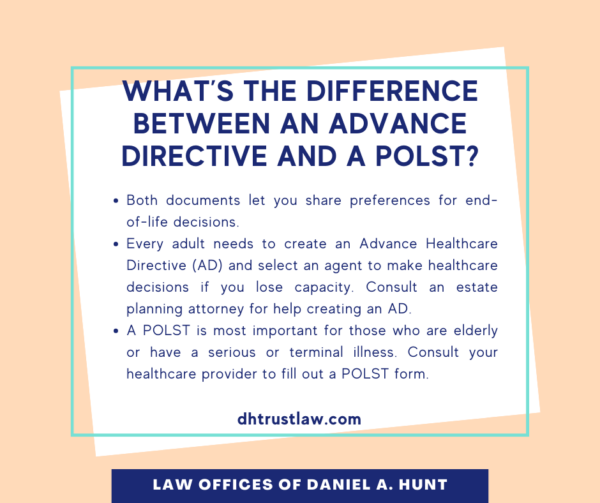What’s the Difference Between an Advance Directive and a POLST?

What’s the difference between an Advance Healthcare Directive and a POLST? We sometimes hear confusion from clients between these two documents, which both pertain to end-of-life choices. This post will explain the difference between an Advance Healthcare Directive and a POLST.
What Is an Advance Healthcare Directive?
An Advance Healthcare Directive (also known as a Power of Attorney for Healthcare or “AD”) is a California legal document that outlines your end-of-life preferences. It also allows you to name an agent to make medical decisions on your behalf if you become incapacitated.
Why Create an Advance Directive?
In addition to designating an agent (and as many alternative agents as you desire), an AD will give direction about end-of-life decisions. If you don’t make your wishes known with an AD ahead of time, your doctor and family members may face some tough decisions.
An AD typically allows you to express your desires about:
- Life support: This includes how long you want to remain on life support if you are in a permanent coma and how many doctors should be consulted concerning your condition.
- Pain medication: This includes whether you want to receive medication for pain relief, such as morphine, that may hasten your death.
- Organ donation: This includes whether you want to donate your organs, which ones, and for what purposes (education, transplant, etc.).
One important element of an Advance Directive is a HIPAA (Health Insurance Portability and Accountability) waiver. If you already have an AD, be sure that your document includes a HIPAA waiver so your agent will have access to your medical history. Otherwise, they may one day need to make decisions concerning your medical care without critical, relevant information.
Newer documents created after 2010 should have a HIPAA waiver. Older documents do not and will need to be replaced.
Who Needs an Advance Directive?
Every person over the age of 18 needs an Advance Directive. We may think that medical crises only happen to the elderly, but the truth is that accidents happen to people of all ages. Be sure that everyone in your family over the age of 18 has an Advance Directive in place.
How to Create an Advance Directive
The best way to create an Advance Directive is to have an experienced estate planning attorney create one on your behalf. Most hospitals will also have generic Advance Directive forms available.
Your AD must be witnessed and signed by a Notary Public OR by two adult witnesses who meet the legal requirements to serve in this role. In California, your witnesses may NOT be:
- A healthcare provider or employee of your healthcare provider
- The operator or an employee of a community care facility
- The operator or an employee of a residential care facility for the elderly
- The person you have appointed as an agent
After you sign your AD, keep the original in a safe but accessible place. Make copies for your agent(s) and bring or send a copy to the hospital or your doctor’s office to be put on your medical record. California also maintains an Advance Directive Registry. As an optional additional step, you can pay a minimal fee and file your AD with the Secretary of State.
Updating your Advance Directive
Review your Advance Directive from time to time. You may want to re-evaluate or replace it if:
- You receive a serious diagnosis
- You get married, separated, or divorced
- Your spouse dies
- Something happens to your agent
- Your preferences change
What Is a POLST?
POLST stands for Physician Orders for Life-Sustaining Treatment. Unlike advance directives, which provide a general outline of your healthcare preferences, a POLST is a more specific document that translates your wishes into actionable instructions for healthcare providers. It is designed to be a portable medical order that travels with you, ensuring that your preferences are known and followed across various healthcare settings.
Why Create a POLST?
Creating a POLST is a proactive step toward taking control of your healthcare decisions, particularly in situations where you may not be able to communicate your preferences. POLSTs are especially important for individuals with serious, life-limiting illnesses or those who want to clearly express their desires for end-of-life care. POLSTs are immediately actionable, providing clarity to healthcare professionals when time is of the essence.
Who Needs a POLST?
While everyone can benefit from having clear healthcare directives, POLSTs are particularly important for individuals with serious or terminal illnesses, frailty, or those at an advanced age. Anyone facing significant health challenges should consider creating a POLST to ensure that their wishes are followed during critical moments when decisions about life-sustaining treatment must be made.
How to Create a POLST
Creating a POLST involves a thoughtful and collaborative process with healthcare professionals. Here’s a step-by-step guide to help you through the process:
- Initiate a Conversation: Begin a candid conversation with your healthcare provider about your healthcare goals, values, and preferences. This is a crucial step in aligning your wishes with the medical interventions available.
- Complete the Form: Work with your healthcare provider to fill out the POLST form. The form covers various aspects of healthcare decisions, including preferences for cardiopulmonary resuscitation (CPR), medical interventions, and artificially administered nutrition.
- Review and Revise: Regularly revisit and revise your POLST in consultation with your healthcare provider. As your health status or preferences change, updating the document ensures that it accurately reflects your wishes.
- Share with Relevant Parties: Distribute copies of your POLST to relevant parties, including your primary care physician, specialists, and family members. It’s essential to make sure that your healthcare team and loved ones are aware of your preferences.
- Keep It Accessible: Carry a copy of your POLST with you, and ensure that healthcare providers in various settings (hospitals, nursing homes, etc.) have access to the document. This ensures that your wishes are known and followed, regardless of where you receive care.
Seek Professional Counsel
To sum it up, an Advance Healthcare Directive and a POLST are two important but distinct documents.
A POLST is recommended for the elderly or those with a serious or terminal illness. It expresses your wishes for end-of-life options such as CPR, medical interventions, and more. Work with your healthcare provider to fill out a POLST form.
An Advance Directive is necessary for all adult Californians. This document allows you to name an agent and express your wishes regarding pain medication, life support, organ donation, and other end-of-life decisions. An estate planning attorney can help you create or update an Advance Directive.
If you have any questions about this topic, feel free to contact our law firm.
Law Offices of Daniel A. Hunt
The Law Offices of Daniel A. Hunt is a California law firm specializing in Estate Planning; Trust Administration & Litigation; Probate; and Conservatorships. We've helped over 10,000 clients find peace of mind. We serve clients throughout the greater Sacramento region and the state of California.




